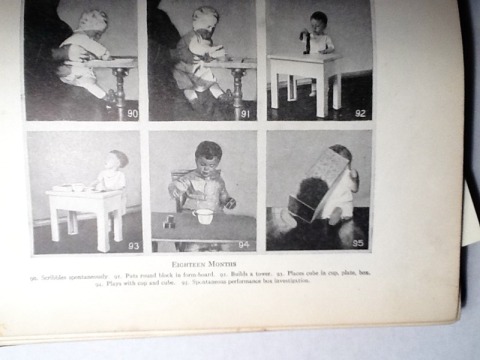The Gesell tests
September 20, 2012
During her first year of infancy Alpha was tested using a set of diagnostic procedures devised by Dr Arnold Gesell, Professor of Child Hygiene and Director at the Yale Psycho-clinic at Yale University in the 1920s. The tests were designed to diagnose defective development in human infants. “An interpretation of developmental status in relation to chronological age and personal-social environment is the diagnostic basis for safeguarding the mental welfare of the pre-school child. Developmental diagnosis is essential to the mental hygiene of infancy” (Gesell, 1930: 8).

“…the hygiene of the pre-school child is gradually coming under systematic social control” (Gesell, 1930: 14).
Gesell’s ‘Syllabus of normative items’ included tests of motor control including: postural control, locomotion, prehension, drawing and hand control (M40 to M48). At 12 months many normal human infants showed the behaviour of scribbling spontaneously when presented with a drawing implement. By the age of 18 months the normal human child would imitate someone drawing and would be able to make a stroke. Abilities that developed later included:
M43 — Copies circle (24 to 48 months)
M44 — Copies diamond in ink (from 60 months)
M46 — Coördinated tracing (36 to 60 months)
M47 — Steadiness Fish test
M48 — Draws a man (48 to 60 months)
The report on Alpha’s first year, during which she was tested using the Gesell syllabus records her progress in M40 as follows:

Around the same time (1931-2) another infant chimpanzee, Gua, who had been adopted into the home of psychologist, W. N. Kellogg for the purpose of comparison with the Kelloggs’ own son Donald, was also given the Gesell tests and was successful in making marks ‘after a brief demonstration by the examiner’ (Morris, 1962: 17).





